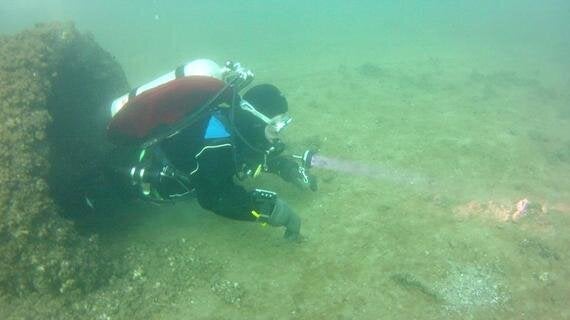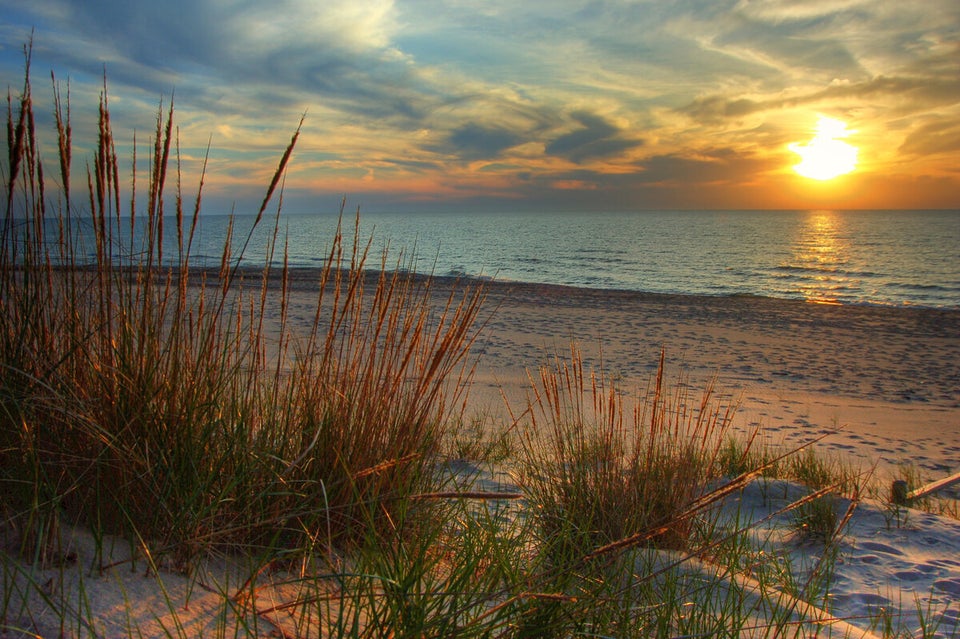
You wouldn't believe the looks of disbelief that we get. When my dive buddy Chris and I decide to spend a morning in Humber Bay, people are apt to ask whether we're serious about swimming in that part of Lake Ontario. One person questioned our sanity.
Of course we're perfectly serious and our mental health is more or less stable. We tell these people that sometimes the clarity of the water can be quite remarkable. I've dived Humber on days when the light filters down to 40 or 50 feet and with a little imagination, you could be diving in the tropics. But I've also dived Humber when the water looks more like a bowl of soup and I can't help but notice the dozens of dead gobies that I see on the bottom. We also recently cancelled a dive because it had been raining all day and when we arrived at the water, there was a disturbing streak of brown water spewing out of the Humber River and curving around into the bay. I didn't know whether it was made up of mud from runoff or possibly raw sewage. We didn't want to find out.
But those two extremes in visible water quality left me wondering about just what was in the water of the Greak Lakes and how polluted (or clean) they really were. I remember growing up in Ontario and hearing horror stories about just how filthy the water was and how contaminated the fish were. But anecdotally, many were saying much had changed. So I started to dig around a little. What I found were some disturbing contradictions. How healthy are the Great Lakes? That depends on who you ask.
The International Joint Commission, a cross-border organization founded in 1909 to mediate disputes and study how the lakes are used by Canada and the United States, says that their measurements show "how well government programs were meeting objectives." They claim that "seven indicators of chemical integrity show mostly favorable or stable result."
They acknowledge that there are some disturbing biological trends and suggest a lot more needs to be done about the problem with "rising surface water temperatures and reduced ice cover." But all in all, their 16th biennial report, published in April 2013, is fairly upbeat about the state of affairs.

Photo courtesy of Robert Osborne
But other groups paint a much darker picture. In a report published just this month, the Canadian Environmental Law Association says, "in recent years a growing body of evidence has indicated the presence, and increasing levels of, new 'chemicals of concern' in the basin." Their bottom line is that while the chemicals governments traditionally track may not be on the rise, there are a host of new pollutants that we know virtually nothing about -- and we should know a lot more because many of these chemicals are killers.
Maude Barlow, in a report called Blue Betrayal published in March of this year, flat out says that "the Harper government has put Canada's freshwater heritage at great risk." She states there are 204 pollutants in the Great Lakes and that the water is full of "fish loaded with contaminants such as mercury, dioxins, lead and PCB's." She points out that Beluga whales that live in the St. Lawrence (part of the Great Lakes waters) are so contaminated that the population has dropped by 90 per cent in just 70 years and of those left, 25 per cent have cancer.
Other reports paint equally sobering pictures. A letter sent this month from an alliance of more than 20 environmental groups to Environment Canada and the U.S. Environmental Protection Agency listed 11 recommendations about actions that needed to be implemented immediately to protect the water quality in the Great Lakes: a body of water that 33 million people depend on for drinking water.
There's little on the government side to counterbalance the claims.
Sobering news for Chris and I. Evidence suggests we're diving in a toxic soup with nobody being really certain how truly toxic it is. Of course we like to tell ourselves that our limited exposure (maybe 20 times a year) and the fact that we're in protective gear makes all the difference. But the truth is we can't be really sure. And the most disturbing part of this whole inquiry is that everything I found points to the fact that the situation will likely get worse. The federal government has systematically dismantled scientific organizations that might have monitored and warned Canadians about growing and new problems.
The really depressing part of this for Chris and I is that having asked the question about what we're diving in and found some answers I can't ignore what I've discovered. I guess we'll just have to find another place to dive.
MORE ON HUFFPOST:
